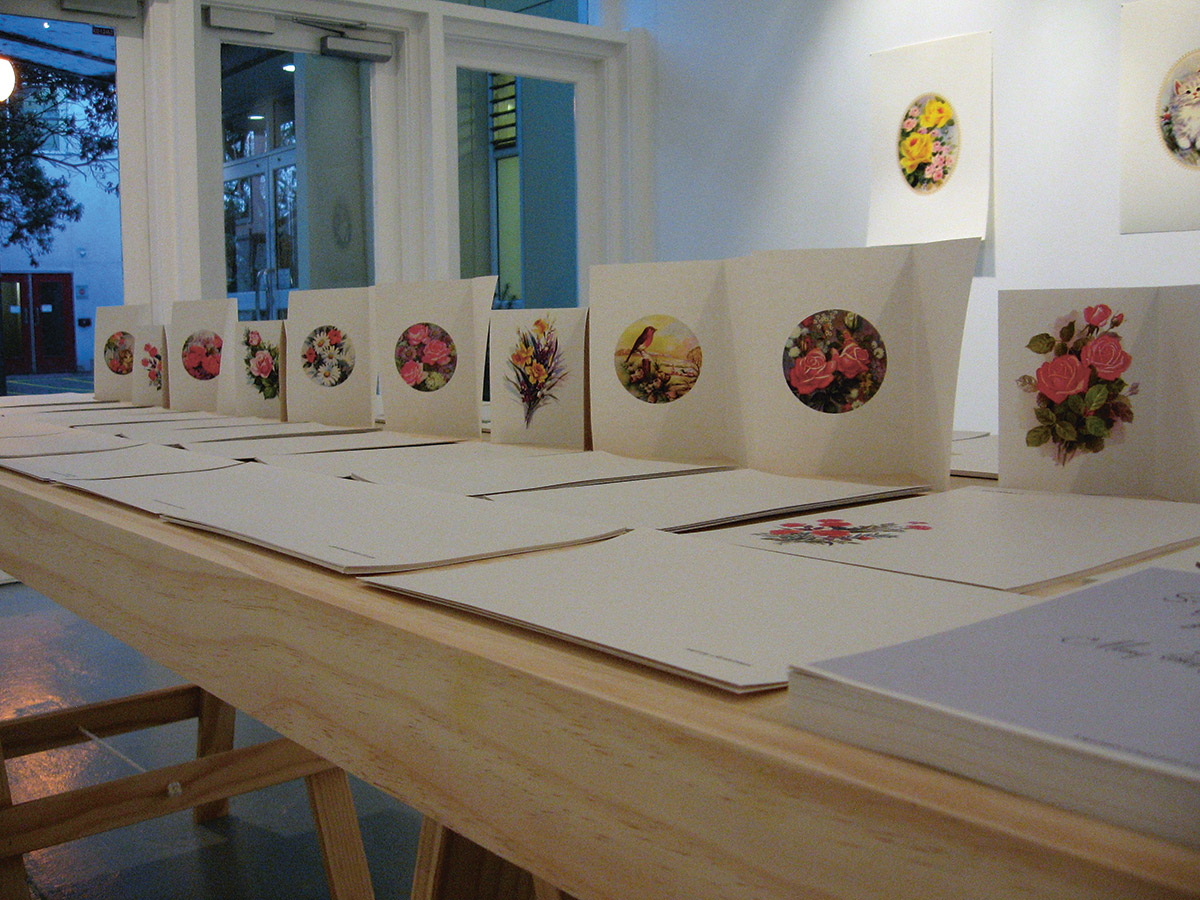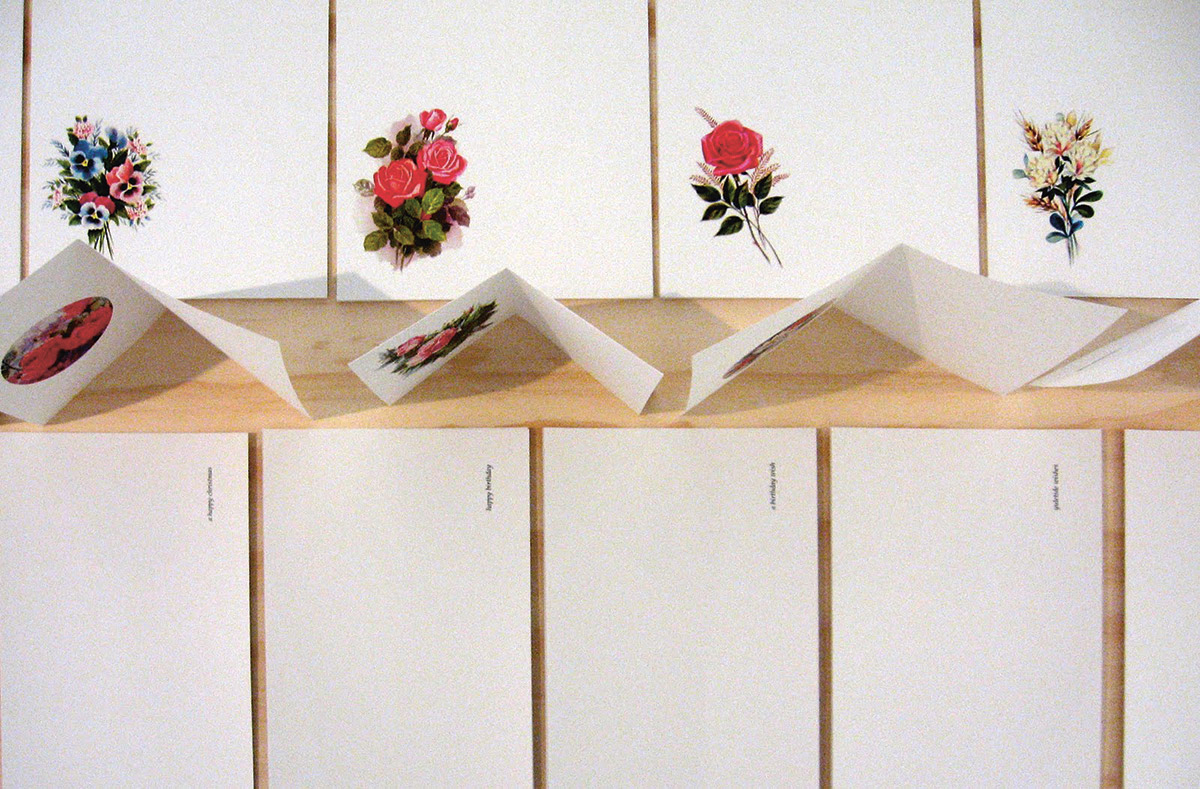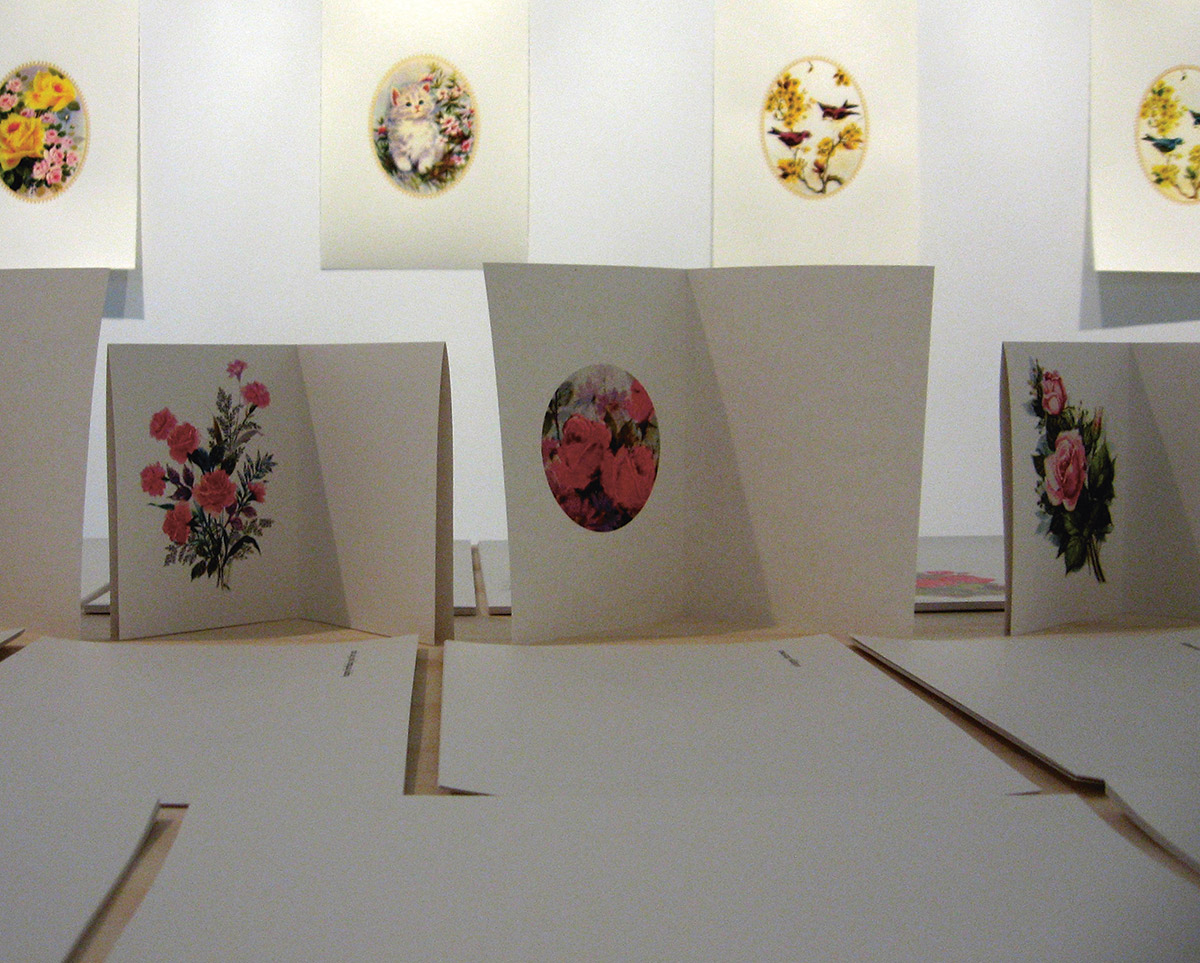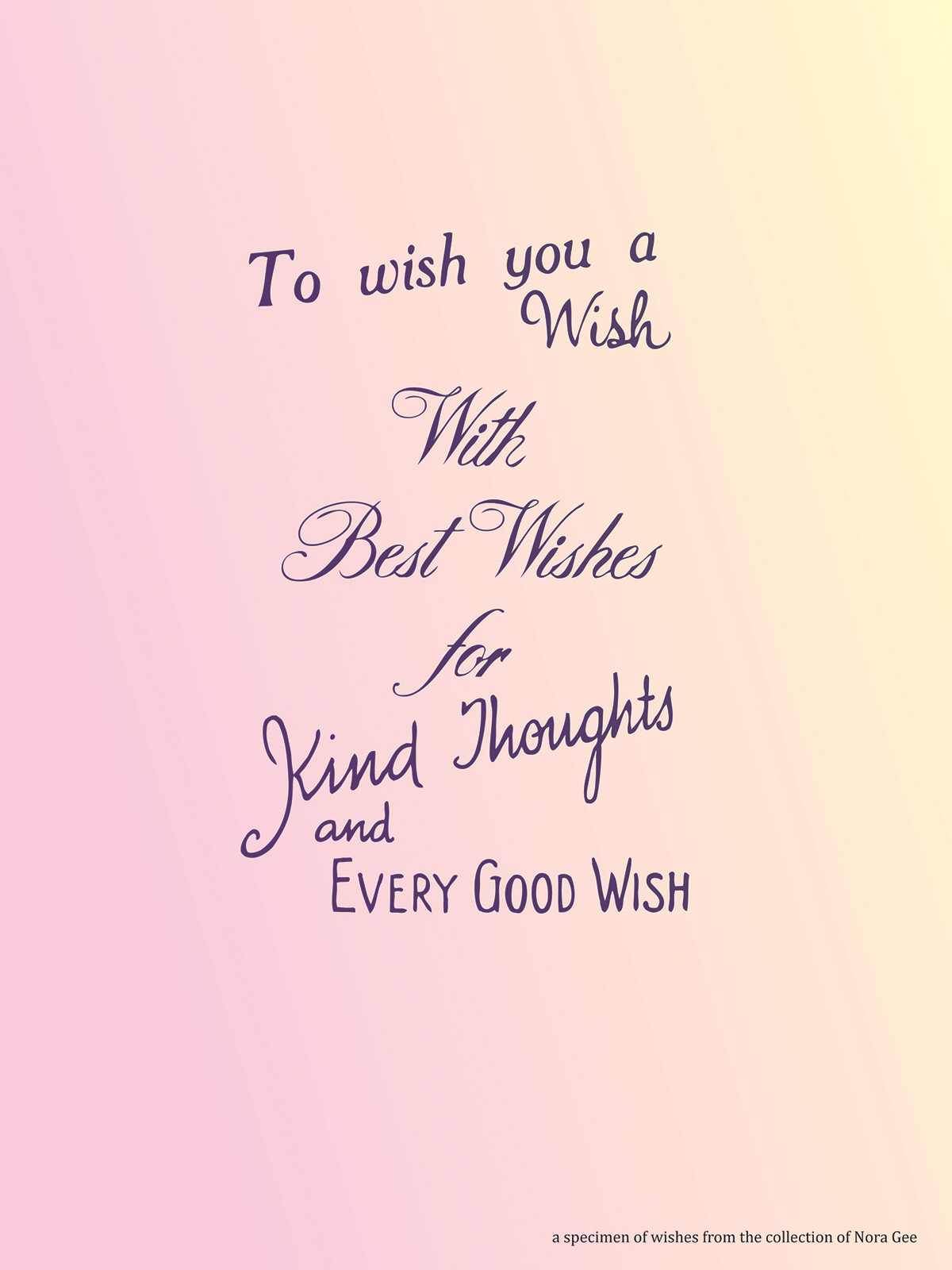Best Wishes Nora Gee – Tracey Williams, Taarati Taiaroa

From the 1940s to the 1970s, Auckland housewife Mrs. Nora Gee kept all of the greeting cards, invitations and telegrams that she was sent from family and friends. Mrs Gee’s personal collection of 837 complete cards was discovered in an antique shop by an Auckland City Library employee and was entered into the library’s Special Collection.
Over three months Tracey Williams and Taarati Taiaroa produced a database from Mrs Gee’s collection. The database recorded in a catalogue, along with wall works and ephemera made in response to the collection and the process of recording it, was presented in an exhibition entitled Best Wishes Nora Gee at Elam School of Fine Arts’ Projectspace B431 on April 22–24, 2010.
I was thinking today about how this whole thing started from our common interest in New Zealand print and ‘small histories’. Nora Gee was the first time we worked together. When we started we talked about how we found the European tradition of print to be heavy baggage. I was trying to get my head around the conceptual justification for using the medium in my work—especially in dealing with New Zealand histories—but the weight of tradition was in the way. Printmaking has been considered in recent years as unfashionable, stuffed in tradition and un-critical—perhaps that’s also why there’s so little academic analysis of it.
At the beginning of our project I began to discover fragments of New Zealand’s print history. Compared to overseas, New Zealand has a brief print history as a tradition imported by European explorers, missionaries, local private presses and governance structures. Originally used as a means for organisation, record keeping, education, community, documentary, propaganda and the dispersion of information, print became more popular as a means of personal expression after 1900.
I do remember talking about how we could use your discoveries to allow a reassessment of what printmaking can be in a local context and in doing so leave the baggage associated with printmaking in the dungeons of Europe. Though ironically, my initial research did focus on this overarching history of print. I wanted to unpack it for myself. I realised that in my work print actually operates as a ‘conceptual strategy’ rather than a medium or technology (although it is of course undoubtedly both).
I’ve thought quite a lot about the notion of print as a stra-tegy. I think I’ve felt, like you, I want to understand why
it continues to underpin my work even though my practice isn’t confined to making prints. The intrinsic properties of printed formats I think work as agents for an expanding artistic practice, and pose methods that bypass established cultural structures. These properties of print include trace, reprocessing, seriality, repetition and multiplicity. Alongside this sits the function of print as a social intervention; its use as a technology with other mediums and formats; and provoking of questions about labour value, originality, and the politics of mass production (this within a fine arts context necessitates consideration of Walter Benjamin’s seminal essay ‘The Work of Art in the Age of Mechanical Reproduction’1).
The products of print have been recognised in different contexts as either aesthetic mediums for the distribution of ideas, or as objects that represent ideas and that are used in a manner connected to print’s history and identity: as a form of reproduction; a system for the mass-distribution of ideas; a means of democratising knowledge; and a mode of social commentary. I would say the traditions of print are the means by which print also paradoxically escapes tradition, gaining the ability to occupy a multitude of positions. Or, in the words of American artist and educator Hugh Merrill: “Print is not an object, a technique, or a category, but it is a theoretical language of evolving ideas.”2
We found Nora Gee’s card collection by systematically going through the entire Auckland City Libraries Ephemera Collection. Despite archives usually being incomplete by their very nature, Nora’s collection presented a sense of completeness and authority that other items in the Ephemera folders did not.
At first glance through the collection, it was obvious that the cards meant a great deal to Nora. They had been looked after very well, and she had her own meticulous system for organising them that involved dating the back of each card.
It was also a significant archive in the way that someone could only really understand it by actually physically encountering the cards—and the sheer number of them. She seemed to have kept every card she had been given during the time she lived in New Zealand.
It seemed really obvious that we needed to enter the cards into a database system — in order to identify patterns in the collection. It was an unconventional way of getting to know someone, but we were able to conclude many odd things about Nora from her cards. We also learned things about the formal and material contents of the actual cards that fascinated us. For example, the average card size in Nora’s collection was 15.3 by 10.8 cm (which we used later to determine the size of the ephemera we made for the exhibition), and contrary to our initial presumptions (about them being apparently ‘generic’ artefacts), rarely was the same phrase or image repeated.
We had such lofty aims when we went into the project. The first thing we decided to do was systematically excavate the entire Auckland Library Ephemera site! And we photographed everything—we had thousands of digital files. This was a very Foucault-ish gesture I think.

We had a kind of blind faith in that process—that a New Zealand print tradition would present itself to us for further investigation.
The Excel sheet had 22 fields detailing cover and interior texts; ‘to’ and ‘from’ fields; card messages; design types and features; design codes; publishers; printing colours; dimensions; occasion details; and descriptions of distinguishing features. We included a ‘category’ field based on several recurring themes that became apparent through handling the cards, but had no institutional relevance like ‘kittens’, ‘birds’ and ‘ships’; and some of the text themes like ‘greetings’ and ‘wishes’.
I think the recognition and establishment of those categories was an important point in the process towards producing outcomes for Best Wishes Nora Gee. Initially the personal nature of Mrs Gee’s collection presented an ethical dilemma, I felt uncomfortable methodically analysing a trail of relationships and life events contained within the cards—it felt like I was grave-robbing or dumpster-diving. I soon got over this, when the database began to take form; developing trends, and (without sounding like a stalker) I began to feel like I knew Nora a bit. I realised that although the relationships in her card collection were important, so was the print quality, design and the actual objects. This was evident in cards where Nora wrote to herself, where she gave a card to someone and then collected it back, and where there were cards between two different people, presumably given to Nora because they knew she liked cards.
We crossed a line at some point in going through Nora’s collection—where we felt like we had begun to know Nora. It stopped being you and me and someone’s cards, and it became about you and me and Nora the person. After that we started looking for ways to ascribe importance and material value by inverting the notion of mass production. We used print to reprocess and consequently materialise traces within the card collection.
The categories of flowers, kittens, birds, and ships were obviously themes that Nora liked, and I would say their
prevalence signified Nora’s values in the cards. Those motifs became a strategy to focus on a print tradition, while acknowledging Nora’s personal history. Which brings me back to your thoughts regarding the ‘Foucault-ish gesture’ underpinning our methodology, although that became more apparent when the project was completed.
In his book The Archaeology of Knowledge Foucault writes about archaeology as a methodology for approaching the archive. I read this as an implication of digging, discovering, sifting, sorting, extracting and organising in order to assemble events and narratives from the system of statements contained in the archive. Elsewhere Charles Merewether has described the aims of Foucault’s ‘knowledge archaeology’ as a way to restructure archival material in order to show how it shapes our relation to the past and the construction of historical meaning.3
In our project we were using these ideas of archaeology to contend with the ephemera archive, but at the same time we were trying to look sideways at it for the ruptures in accustomed systems and values—which may be more of a Lyotard-esque gesture.4 He calls for the recognition of a series of mini-narratives that are temporary and contingent, and provide a basis for people’s actions in specific groups in particular local circumstances. We were interested in how the structure of the archive could be reconfigured to offer new narratives, or to recuperate mini-narratives, and we were trying to reorganise value systems. Lyotard’s thoughts were in fact fundamental to the project all the way through.
Particularly throughout the research process, where we constantly had to edit what we were investigating. The more the collection was unpacked, the greater the opportunities were for getting side-tracked. There are so many small histories entangled in the object of a card, and there were many gaps of knowledge in the collection that could easily justify further investigation. It is very easy for the inner historian to take over. Before you know it you’re researching New Zealand card manufacturers of the mid-20th century.
The project was a process of constant refinement. This was very useful for my practice, as it taught me to trust the process right to the end. Despite many points of interest being disregarded, there somehow were still multiple levels of conversation that were present in the exhibition. I think this happened because the exhibition was presented as a case-study of what print might be—it was not definitive but rather full of possibility.
I think that possibility arose because our method was quite experimental—engaging the archive in collaboration with print. Also we weren’t looking for answers, rather asking a question—something along the lines of: ‘What can we find out about the application of print in a local context and how can that knowledge be used as a new layer of history through creative practice?’ Print was a subject in our project in that concepts, materiality, dispersion and collection of print ephemera were applied in order to activate a localised narrative; and print was also an object whereby strategies emerged for approaching and presenting archival material to take up new positions with regard to social engagement.
One of these strategies, the re-activation of the function of Nora’s cards as ephemeral objects, was through keepsakes that the audience was invited to take away, and this was of huge importance to the project. Designed to activate an appreciation of the utility of the printed object, the keep-sakes were made in direct reference to individual cards and design trends of the collection. They were editioned according to the rarity of their category (kittens and birds were rare, flowers were very common) and can all be traced back through our database to the original object.

Thinking of these reconfigured elements of Nora’s collection dispersed into new contexts, I think the exhibition was true to our original intentions. The artefacts we came up with through our engagement of the archive contribute to local knowledge as vehicles for new, small, reconfigured, imagined or forgotten narratives. They were built out of history but they also refuse it. The way we used print methods to intersect, order, artic-ulate and distribute Nora’s story allows a small history to have a place in discursive systems alongside standard dominant narratives. Recently I read an analysis of Lyotard’s ideas, in which the writer spoke about the notion of paralogy that Lyotard offered as a means to counter grand narratives, which I think our project is true to. This concept refers to the need for systems that encourage, introduce or allow for diversity, the fertile search for new meanings and allow for the unknown.5
Although Nora’s story was no grand narrative it is interesting how all-consuming she became. We often found ourselves saying: ‘yes, Nora would like that’ in making decisions for the exhibition. I was initially worried how people would interpret the work without seeing the depth of our research—of which the show was just a slice. So it was refreshing when I talked about the cards to people they would pick up on the little things often transgressing into stories about their mothers or aunts or friends who keep similar collections. Nora became a kind of ‘everywoman’ in her ability to establish some rapport with the audience. Suddenly one woman’s collection exemplified a larger print and social tradition.
Concentrating on the cards for so many hours while we compiled the database and the way we handled all of the cards and scrutinised them for information was a myopic experience. There were little facts we gleaned: like that she kept cards she gave to other people, and, touchingly, that she wrote anniversary cards to her husband after he died. We also learned she immigrated to New Zealand in the 1940s and that’s when the card collection started (with Bon Voyage cards).
But also there turned out to be lots of things we thought we knew about her that in fact were not so. For example, we were sure she had no children of her own. We found this was incorrect when her grandson Larry contacted us a while after our exhibition. One of Nora’s descendants was doing a school project on family history and came across our project on the Internet, which led Larry to us. He was very generous—animating Nora for us. This was quite an uncanny experience as we found out Nora’s brother Charles was a printer and Nora worked at Charles’s shop! She first worked at Gem Press in Day Street off Karangahape Road then at the top of Mt Eden Road right next to where the Powerstation is situated now. Nora lost three fingers on the guillotine at this printer; despite this she still played the piano! From stories Larry told us it became obvious that Nora was actually more than an ordinary ‘every-woman’.
In hindsight, the process of finding out more about Nora after being sure we had discovered facts through the archive is an interesting observation regarding the use of archives to build narratives in general. Only so much can be revealed. With Nora we see the imaginary aspects of the narrative because we were given more information from a primary source. Not that we were looking for a narrative that made sense; we liked the gaps and ambiguities and were intent on having them on the surface of the project, but in retrospect I see that in spite of this intent, our longing to make some kind of sense of what we encountered threaded together the little stories within the larger story of Nora Gee. However, here I want to go back to your statement: ‘suddenly one woman’s collection exemplified a larger print and social tradition’. We started our project looking for information about local print histories so I’m really interested in your ideas now about exactly what that larger print (and social) tradition consists of—and what it might reveal about local traditions related to print.
Actually I think it’s more the other way round—where a single local history might reveal or allude to a larger print and social tradition. Nora’s story was a perfect example of an imported print tradition (Bon Voyage cards) instituting itself in a New Zealand local context. The value of the cards to Nora was their ritual function—a ritual function that she kept alive through continuing a tradition of card giving/receiving and ultimately collecting, with her friends and family. When people I talked to about Nora transgressed into their own stories, it became obvious that her collection and ritual was a common social tradition, that she was just a piece of—which fits our whole project being a case study. The fact that they were printed objects was what allowed the cards to function. After learning that Nora had worked in print shops just down the road from our exhibition reaffirmed the richness of Nora Gee’s card collection as an example of the local use and appreciation of print. For me, Best Wishes Nora Gee highlighted the dependence on print to perform a function within a community as a key factor in what constitutes a New Zealand print tradition. Making is a consequence of use rather than the other way round.
This point resonates with something I remember we talked about at the very start of our project after I read about the ‘20/20 Vision Group’. In 1964 the Group brought about a reaction against the preoccupation with technique (over and above ideas inherent in artwork), aiming to experiment with new forms and materials, and the providence of a forum for their ideas.6 One of the events it organised was a show of commercial screenprint multiples that sold for two dollars each. With multiples the Group wanted to subvert ‘handmade preciousness’ and craftsmanship with the democratic process of mass-production.7 Commercially produced prints embodied this ideal. Participants in subsequent shows of multiples by the Group included Greer Twiss, Derek Mitchell, Don Peebles, John Coley, John Drawbridge and Vivian Bishop. We talked about how the Group used print technology as a strategy to engage with social and political concerns of the time. I’d like to suggest that perhaps the notion we have come to regarding print being a strategy for art is an identifiable characteristic of New Zealand print history—which is what we were hunting for through our research. This idea came up in the symposium we held on the last day of the exhibition where we ended with a discussion about the term ‘printmaking’ as referring to something entirely different than the term ‘print’.

Footnotes
In Walter Benjamin, Illuminations. London: Jonathan Cape Ltd, 1970. pp.219-253. ↵
Hugh Merrill, ‘Educating the Next Generation of Printmakers’, http://www.hughmerrill.com/writing/nextgen.html, 1991. (retrieved 3.12.2010) ↵
Charles Merewether, ‘Introduction/Art and the Archive’, The Archive/ Documents of Contemporary Art. Cambridge: MIT Press and London: Whitechapel Ventures, 2006. p.11. ↵
In The Postmodern Condition: A Report on Knowledge, Lyotard conveyed the ‘incredulity toward metanarratives’ defining postmodernism (Lyotard, 1979, xxiv). He theorised that in postmodernity authoritarian, expounding narratives like Christianity, scientific progress and Marxism are no longer tenable—advocating instead a multitude of fragmented localised narratives as an approach to knowledge. (Jean-François Lyotard, The Postmodern Condition: A Report on Knowledge. Manchester: Manchester University Press, 1979.) ↵
Martin Halbert, ‘Lyotard: The Postmodern Condition’, http://userwww.service.emory.edu/~mhalber/Research/Paper/pci-lyotard.html (retrieved 23/12/2010) ↵
Anne Kirker, ‘A History of Printmaking in New Zealand’, Thesis (Dip FA hons). University of Auckland, 1969. p.52. ↵
Ibid. p.51. ↵